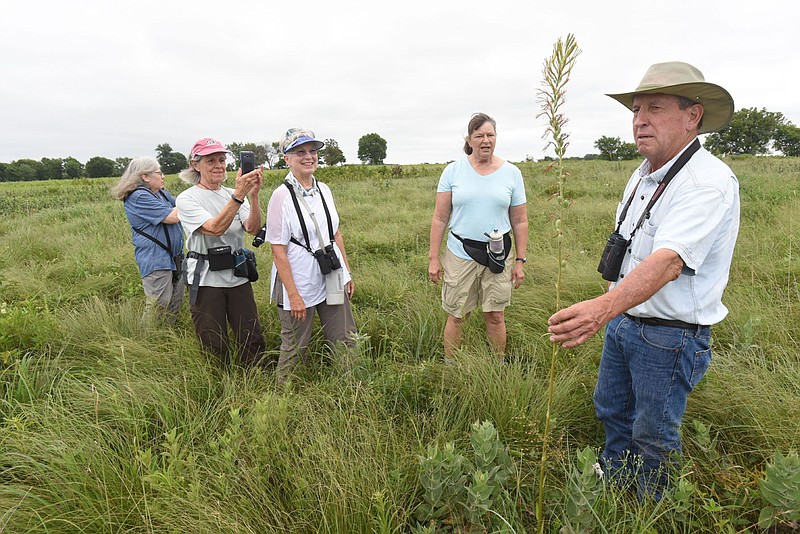SILOAM SPRINGS -- Forests are far away on this short summertime hike. Not one bluff or hilltop is in sight.
Waving strands of native grass, wildflowers in colorful bloom and singing birds bring visitors to Chesney Prairie Natural Area on the eastern edge of Siloam Springs.
The 83-acre tract, administered by the Arkansas Natural Heritage Commission, is one of the last tallgrass prairie remnants left in Northwest Arkansas. Everyone is welcome to wander mowed pathways that meander for three miles through waist-high stands of grass and flowers that wave when a summer breeze blows.
Heat and humidity can bake Chesney Prairie in summer. Some 15 visitors with the Northwest Arkansas Audubon Society welcomed an unusually cool and cloudy mid-July Saturday morning for their annual summertime field trip at Chesney.
Joe Woolbright, caretaker at Chesney Prairie Natural Area, and Joe Neal with the Audubon group led the morning field trip. Woolbright is a walking, talking guidebook of wildflowers and native grasses. Neal is equally adept with birds, being one of the region's leading experts on all creatures feathered.
Blossoms got the attention of visitors more than birds on this summer's field trip. Woolbright led the group to wildflowers with names like rattlesnake master, bull nettle and Arkansas Ironweed.
"More than 300 native plant species have been documented here," Woolbright said. The prairie's diverse habitat allows so many varieties.
"There's five different natural communities on this prairie," he said. Soil types in these range from dry to damp to wet. Small tracts of woods dot the landscape.
"That's why you have this diversity," he explained. Different plants grow in each soil type.
Neal pointed out a fast-flying flock of mourning doves and graceful turkey vultures soaring so high they appeared small as songbirds. A beetle on one wildflower blossom got Neal most excited.
"Oh there's one of those very cool beetles on it. Look, you can get right up close to it. It's a scarab," Neal said. A computer search reveals there are some 30,000 species of scarab beetles worldwide. Many have teeth-like points on their front legs for digging in the dirt.
This wasn't the first prairie rodeo for the Audubon group. Most wore knee-high boots and long pants for wandering off the grassy paths that Woolbright keeps mowed for more pleasant walking. A wide-brimmed hat, insect repellent, sunscreen and water are standard gear for a prairie walk.
Best time to visit Chesney Prairie Natural Area is any time during the growing season, Woolbright said. In the heat of August, early morning prairie walks might be in order.





More News
Visit Chesney Prairie Natural Area
From the intersection of U.S. 412 and Arkansas 59 in Siloam Springs, drive north on Arkansas 59 for two miles to Bill Young Road. Turn right (east) on Bill Young Road.
Go approximately 0.75 miles to a gravel farm road on the left. Turn left (north) on this farm road and drive 0.63 miles to a dead end at some poultry barns. Park here. The Chesney Prairie Natural Area sign and entrance are near the poultry barns.
Source: Arkansas Natural Heritage Commission

